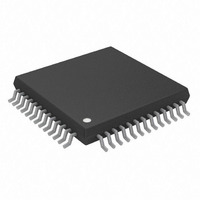AD5391BSTZ-5 Analog Devices Inc, AD5391BSTZ-5 Datasheet - Page 26

AD5391BSTZ-5
Manufacturer Part Number
AD5391BSTZ-5
Description
IC DAC 12BIT 16CHAN 3V 52LQFP
Manufacturer
Analog Devices Inc
Specifications of AD5391BSTZ-5
Data Interface
I²C, Serial
Design Resources
8 to 16 Channels of Programmable Voltage with Excellent Temperature Drift Performance Using AD5390/1/2 (CN0029) AD5390/91/92 Channel Monitor Function (CN0030)
Settling Time
6µs
Number Of Bits
12
Number Of Converters
16
Voltage Supply Source
Single Supply
Power Dissipation (max)
35mW
Operating Temperature
-40°C ~ 85°C
Mounting Type
Surface Mount
Package / Case
52-LQFP
Resolution (bits)
12bit
Sampling Rate
167kSPS
Input Channel Type
Serial
Supply Voltage Range - Analogue
4.5V To 5.5V
Supply Voltage Range - Digital
2.7V To 5.5V
Lead Free Status / RoHS Status
Lead free / RoHS Compliant
For Use With
EVAL-AD5391EBZ - BOARD EVALUATION FOR AD5391
Lead Free Status / RoHS Status
Lead free / RoHS Compliant, Lead free / RoHS Compliant
Available stocks
Company
Part Number
Manufacturer
Quantity
Price
Company:
Part Number:
AD5391BSTZ-5
Manufacturer:
Analog Devices Inc
Quantity:
10 000
Part Number:
AD5391BSTZ-5
Manufacturer:
ADI/亚德诺
Quantity:
20 000
AD5390/AD5391/AD5392
I
The AD5390/AD5391/AD5392 feature an I
2-wire interface consisting of a serial data line (SDA) and a
serial clock line (SCL). SDA and SCL facilitate communication
between the DACs and the master at rates up to 400 kHz.
Figure 6 shows the 2-wire interface timing diagram.
When selecting the I
SPI/ I
as a slave device, that is, no clock is generated by the device.
The AD5390/AD5391/AD5392 have a 7-bit slave address 1010 1
(AD1)(AD0). The five MSBs are hard-coded and the two LSBs
are determined by the state of the AD1 and AD0 pins. The
hardware configuration facility for the AD1 and AD0 pins
allows four of these devices to be configured on the bus.
I
One data bit is transferred during each SCL clock cycle. The
data on SDA must remain stable during the high period of the
SCL clock pulse. Changes in SDA while SCL is high are control
signals that configure START and STOP conditions. Both SDA
and SCL are pulled high by the external pull-up resistors when
the I
START and STOP Conditions
A master device initiates communication by issuing a START
condition. A START condition is a high-to-low transition on
SDA with SCL high. A STOP condition is a low-to-high trans-
ition on SDA, while SCL is high. A START condition from the
master signals the beginning of a transmission to the AD539x.
The STOP condition frees the bus. If a repeated START
condition (Sr) is generated instead of a STOP condition, the
bus remains active.
2
2
C Data Transfer
C SERIAL INTERFACE
2
2
C bus is not busy.
C pin to Logic 0, the device is connected to the I
2
C operating mode by configuring the
2
C-compatible
2
C bus
Rev. C | Page 26 of 40
Repeated START Condition
A repeated START (Sr) condition may indicate a change of data
direction on the bus. Sr may be used when the bus master is
writing to several I
control of the bus.
Acknowledge Bit (ACK)
The acknowledge bit (ACK) is the ninth bit attached to any 8-bit
data-word. An ACK is always generated by the receiving device.
The AD539x devices generate an ACK when receiving an address
or data by pulling SDA low during the ninth clock period.
Monitoring the ACK allows for detection of unsuccessful data
transfers. An unsuccessful data transfer occurs if a receiving
device is busy or if a system fault has occurred. In the event of
an unsuccessful data transfer, the bus master should reattempt
communication.
AD539X Slave Addresses
A bus master initiates communication with a slave device by
issuing a START condition followed by the 7-bit slave address.
When idle, the AD539x device waits for a START condition
followed by its slave address. The LSB of the address word is
the read/write (R/ W ) bit. The AD539x devices are receive
devices only and R/ W = 0 when communicating with them.
After receiving the proper address 1010 1(AD1) (AD0), the
AD539x issues an ACK by pulling SDA low for one clock cycle.
The AD539x has four user-programmable addresses determined
by the AD1 and AD0 bits.
2
C devices and does not want to relinquish














